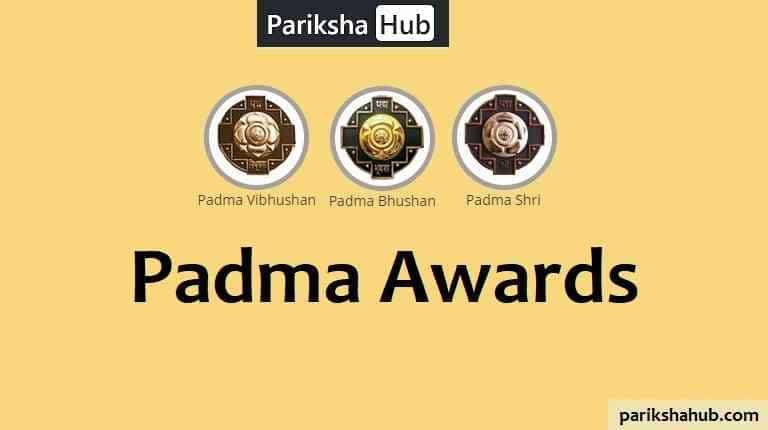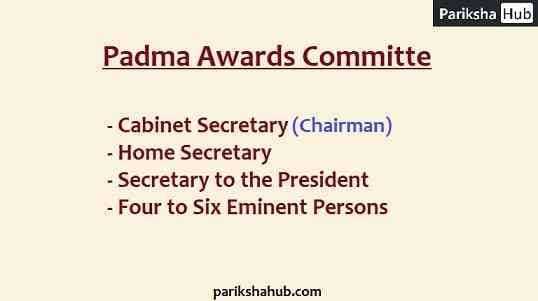The Padma Awards are one of the highest civilian awards of India. They are presented every year on the Republic Day of India i.e.. 26th January. They seek to recognize achievements in all fields of activities or disciplines where an element of public service is involved. The Padma Awards are given in three categories: Padma Vibhushan (for exceptional and distinguished service), Padma Bhushan (distinguished service of higher order) and Padma Shri (distinguished service). In this article we shall see the details of the different Padma Awards and their eligibility and selection criteria, Padma Awards Committee, Padma Awards fields and more.
Every year from 1st May to 15th September nominations for the next year Padma Awards are invited from Governments (Centre, State and UT), PSU’s, Previous Bharat Ratna and Padma Awardees, Private Individuals etc. The Padma Awards Committee reviews all the nominations and present their recommendations to the Prime Minister and the President for approval.
Padma Awards
In 1954, the Government of India instituted two civilian awards- 1) Bharat Ratna & 2) Padma Vibhushan. However, the Padma Vibhushan had three classes namely Pahela Varg, Dusra Varg and Tisra Varg. These were subsequently renamed as Padma Vibhushan, Padma Bhushan and Padma Shri through a Presidential Notification issued on January 8, 1955.
- Padma Vibhushan for exceptional and distinguished service
- Padma Bhushan for distinguished service of a high order
- Padma Shri for distinguished service
Padma Vibhushan
Padma Vibhushan is the second highest civilian award of India (the first being Bharat Ratna). It is awarded for exceptional and distinguished service. They can be awarded posthumously and also to Non-Citizens. As of 2021, 321 individuals were awarded Padma Vibhushan.
The first recipients of the Padma Vibhushan award were Satyendra Nath Bose, Nand Lal Bose, Zakir Hussain, Balasaheb Gangadhar Kher, Jigme Dorji Wangchuck, and V. K. Krishna Menon.
All the Padma Awards were suspended twice, from July 1977 to January 1980 and from August 1992 to December 1995.
Some Padma Vibhushan recipients refused or returned their awards. P. N. Haksar, Vilayat Khan, E. M. S. Namboodiripad, Swami Ranganathananda, and Manikonda Chalapathi Rau refused the award, the family members of Lakshmi Chand Jain (2011) and Sharad Anantrao Joshi (2016) declined their posthumous conferments, and Baba Amte, who was awarded in 986 returned it back in 1991.
Padma Bhushan
Padma Bhushan is the third highest civilian award of India. It is awarded for distinguished service of a higher order. They can be awarded posthumously. As of 2021, 1270 individuals were awarded Padma Bhushan.
Padma Shri
Padma Shri is the fourth highest civilian award of India. It is awarded for distinguished service. They can be awarded posthumously. As of 2021, 3225 individuals were awarded Padma Vibhushan.
Padma Awards Committee
The Padma Awards Committee is constituted by the Prime Minister every year. It is headed by the Cabinet Secretary and includes Home Secretary, Secretary to the President and four to six eminent persons as members.
Padma Awards Eligibility
All persons without distinction of race, occupation, position or sex are eligible for these awards. However, Government servants including those working with PSUs, except doctors and scientists, are not eligible for these Awards.
Padma Awards Selection Criteria
There is no rigid criteria or formula that is applied for Padma Awards Selection. However, the Padma Awards Committee says that, it looks for life time achievement of an individual while making a selection. There ought to be an element of public service in the achievements of the person to be selected. The award is given for ‘special services’ and not merely for long service. It should not be merely excellence in a particular field, but the criteria has to be “excellence plus”.
Padma Awards Fields
The award seeks to recognize works of distinction and is given for distinguished and exceptional achievements / service in all fields of activities/disciplines. An illustrative list of the fields is as under:
- Art (includes Music, Painting, Sculpture, Photography, Cinema, Theatre etc.)
- Social work (includes social service, charitable service, contribution in community projects etc.)
- Public Affairs (includes Law, Public Life, Politics etc.)
- Science & Engineering (includes Space Engineering, Nuclear Science, Information Technology, Research & Development in Science & its allied subjects etc.)
- Trade & Industry (includes Banking, Economic Activities, Management, Promotion of Tourism, Business etc.)
- Medicine (includes medical research, distinction/specialization in Ayurveda, Homeopathy, Sidhha, Allopathy, Naturopathy etc.)
- Literature & Education (includes Journalism, Teaching, Book composing, Literature, Poetry, Promotion of education, Promotion of literacy, Education Reforms etc.)
- Civil Service (includes distinction/excellence in administration etc. by Government Servants)
- Sports (includes popular Sports, Athletics, Adventure, Mountaineering, promotion of sports, Yoga etc.)
- Others (fields not covered above and may include propagation of Indian Culture, protection of Human Rights, Wild Life protection/conservation etc.)

